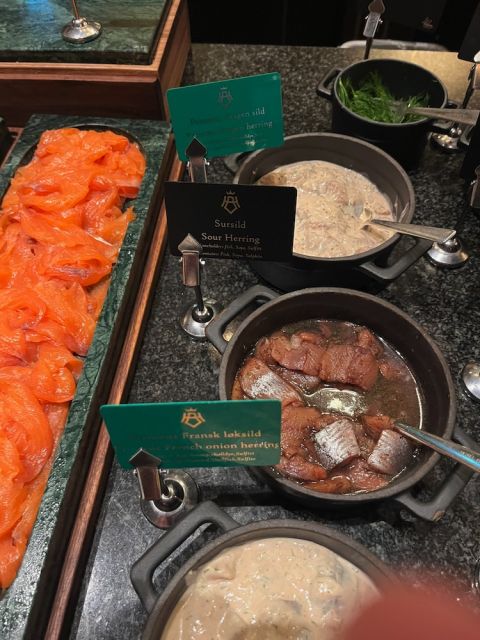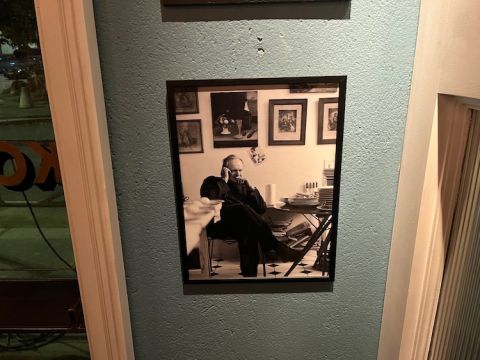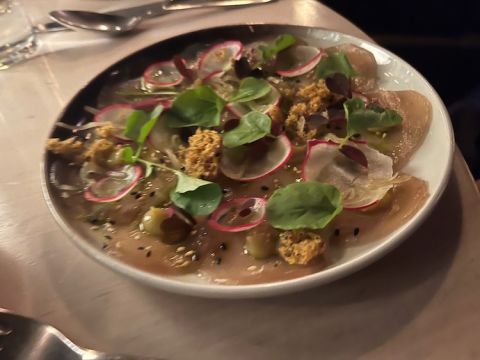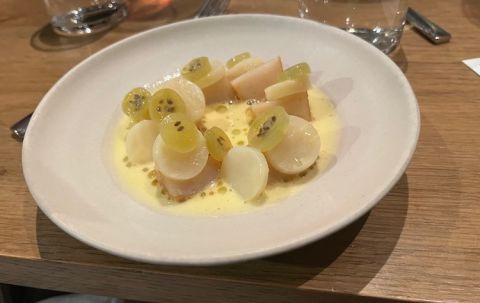Eating out in Oslo

Nick and Jancis were given a warm welcome in Oslo this week. Three strong recommendations below.
For herring
My brother’s exhortation ‘to have a herring for me’ arrived via WhatsApp about an hour too late. By that time I had enjoyed at least three (shown below next to the salmon on the breakfast buffet).
It was 2 pm and we had just settled into the busy, comfortable lobby restaurant of the Hotel Bristol. This area, referred to as the Vinterhaven & Bibliotekbaren (Winter Garden and Library Bar), acts as an all-day café and the locals seem to love its wide selection of open sandwiches and cakes, relatively exotic teas and coffee and smiling, professional service.
The ‘down a herring’ plate Sild (which translates as a small, immature herring) hit the spot for a first visit to Norway in many decades. It includes herring prepared in three ways (sweet-and-sour; with a creamy French onion dressing; and with an egg-and-shellfish dressing). Each of these came in a medium-sized glass jar for two to share, served with rye bread, the ubiquitous crispbread, boiled eggs and dill. It was the perfect welcome to Norway and these pots were soon empty (245 krone or £19 per person). Their creamy pavlova cake is almost as good.
But perhaps the most satisfying aspect of sitting here is simply the pleasure of listening to a room full of people speaking Norwegian and not understanding a word.
Hotel Bristol Kristian IVs gate 7, 0164 Oslo; tel: +47 22 82 60 22
For wine
Norwegian enthusiasm for wine is a fairly recent phenomenon that has grown out of the spectacular growth in the country’s economy over the past 30 years. The Vinmonopolet monopoly employs in its 350 stores many people who care about what is drunk but face one particular challenge: they have very little by way of older vintages.
This is also the only criticism that can be levelled against the otherwise magnificent wine list on offer at Kolonialen restaurant in Sofies Gate, a ten-minute taxi ride from the centre. This place is the creation of Pontus Dahlström, a Finn who was a founding partner in Oslo’s Maaemo restaurant, the country’s famous three-star Michelin restaurant where the menu currently costs £350 per person.
His wine list is crammed full of all the best names from France, Italy, Spain and California, with Burgundy a speciality. Ridge, Lafon, Roumier and Aldo Conterno all jostle for space; Bordeaux is arguably less well represented. The champagne range is impressive. And so, too, is the ‘wall of empties’, a collection of empty bottles that occupies the back-lit wall of the restaurant, testimony to the amount of pleasure generated.
We ordered a bottle of Roumier’s 2017 Morey-St-Denis Clos de la Bussière which the waiter brought with considerable enthusiasm along with a decanter and three glasses. He poured himself a little and grimaced. ‘I believe it’s corked’, he exclaimed, ‘and this was our last bottle, I’m afraid.’ He poured some for Jancis who had to agree. ‘I think we only had two left and I sold another one the other evening but I will go and check.’ He came back after five minutes with a smile on his face, carrying another bottle of the 2017. ‘I must have been mistaken’, he continued as he opened the second bottle which is magnificent: subtle, warm (figuratively) and with a long, long finish.
The ‘wall of empties’ is part of an interior that seems to belie the seven years the restaurant has been open – it feels extremely comfortable, well-worn but still welcoming (a new wine bar, finished to the same specification next door, is due to open next week). This is helped by black-and-white photographs of Paul Bocuse, looking very much like a Pope, next to an extremely large bottle of Delamain cognac, and another of Joël Robuchon (below) who, for once, seems to be relaxed and relaxing.
The food is good but, perhaps not surprisingly, was not quite as exciting as the wine list. We enjoyed a carpaccio of tuna (above) that was slightly too tart and a beef tartare spiced with crisp shavings of salsify. Even more satisfying was a torchon of foie gras topped with the thinnest glaze served with a profiterole stuffed with onion chutney, and agnolotti stuffed with ricotta and topped with lardo, cherry tomatoes and pine nuts that provided the necessary contrasting crunch. For dessert we simply finished the red burgundy and paid our bill of 4,317 krone of which the wine was 3,200 (£242, when Wine-Searcher’s average retail price is £377). (We felt duty-bound to benefit from what the manager of the flagship Vinmonopolet store tells visitors: ‘In Norway cheap wine is expensive but expensive wine is relatively cheap’.)
Kolonialen Sofiesgate 16, 0170 Oslo; tel: +47 90 11 50 98
For impressive cooking
There had already been plenty of praise for the cooking at the Restaurant Hot Shop before we were even dropped outside its prominent corner site. But first of all, a word about its name.
The restaurant, which opened five years ago, used to be a sex shop and the new owners decided to keep the name. When I congratulated Erlend Lehland, manager of the Hot Shop (seen at the top of this article), on what appeared to me as a smart move, he demurred, ‘Yes, but still we get a number of people who seem to expect hotter food, something Asian.’
The Hot Shop seats about 36 customers in a room that is full of light wood and, presumably unlike its former incarnation, one with large glass windows on both sides. The kitchen is tucked away with only the pastry section visible and the room is decorated with large photographs by Nils Olav Bøe, a visual artist who also happens to be the father of the chef.
The menu on our table was soon supplemented by the wine list, several pages of closely typed wines without any notes, but a handsome of array of Keller wines that had just been added. This silenced Jancis who had had a long day presenting the new Oxford Companion to Wine and her glassware to three different audiences. She promptly ordered a bottle of Giuseppe Rinaldi’s Barolo Brunate 2018 for 3,250 kroner (£250 – £263 average retail on Wine-Searcher) which proved an admirable choice for the food. The Norwegians, we are told, like acidity in their food and this is an element that predominated, but never excessively so, in all that we ate.
We began with a couple of snacks, the second of which – diced crab spiced most effectively with a chilli pepper grown in Norway by their duck farmer – was memorable. Then came three fish dishes: a soothing bowl of oyster cream topped with diced sweet baby turnips and lovage; a visually slightly similar bowl of extremely sweet scallops topped with crunchy slices of celeriac and perhaps slightly too acidic gooseberries (pictured above); and then a piece of turbot on their intensely shellfish-based version of an XO sauce whose spiciness was added to by the addition of four chocolate cherry tomatoes, an ingredient new to both of us.
This was followed by a main course, two slices from a saddle of lamb from Viksdalen, north of Bergen, whose crunchy skin was absolutely delicious, and then dessert – buttermilk ice cream, quickly blowtorched, on a thick purée of blueberries and lilac. We paid a bill of 5,840 kroner (£450) without service, never included in Norwegian restaurants, of which our bottle of wine cost 60%, and left very happy.
In fact, I would go so far as to describe the Restaurant Hot Shop as a very happy place. All the other customers, all Norwegian and mostly much younger than us, seemed to be having a very good time and left with smiles on their faces. This was, I am sure, partly due to the food and wine but mostly due to the quality of the service which was relaxed and prompt. Lehland told me that post-Covid the restaurant has settled into a workable, and profitable, pattern of serving dinner only Wednesday to Saturday evenings. Proof that an obviously happy staff results in happy customers.
Restaurant Hot Shop Kobenhavngata 18, 0566 Oslo; tel: +47 46 67 37 18
Become a member to view this article and thousands more!
- 15,407 featured articles
- 274,946 wine reviews
- Maps from The World Atlas of Wine, 8th edition (RRP £50)
- The Oxford Companion to Wine, 5th edition (RRP £50)
- Members’ forum
- 15,407 featured articles
- 274,946 wine reviews
- Maps from The World Atlas of Wine, 8th edition (RRP £50)
- The Oxford Companion to Wine, 5th edition (RRP £50)
- Members’ forum
- 48-hour preview of all scheduled articles
- Commercial use of our wine reviews






